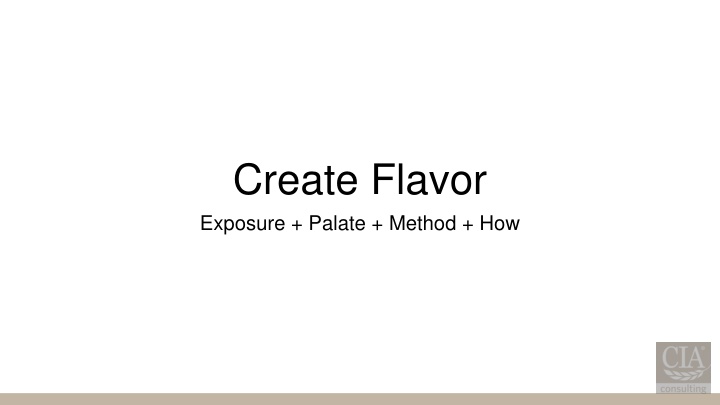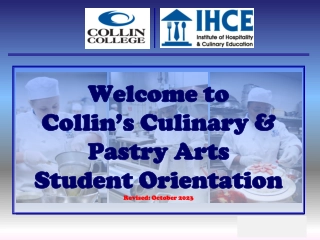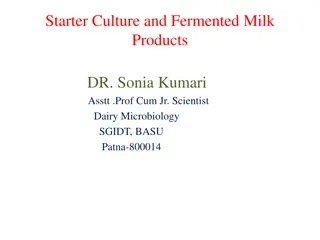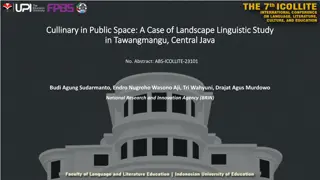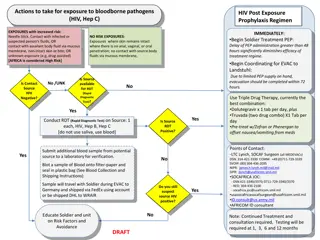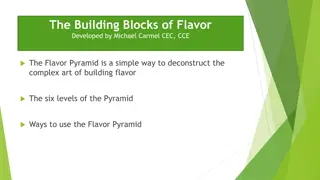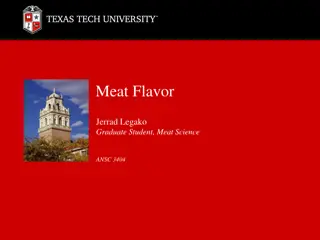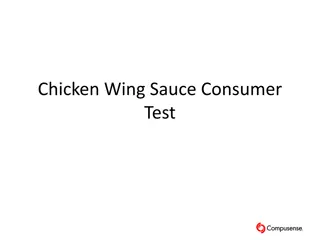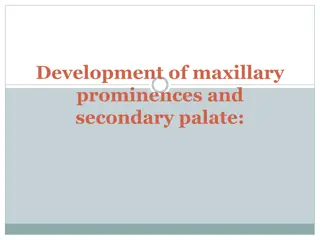Flavor: A Culinary Journey Through Exposure, Palate, and Method
Embark on a sensory culinary adventure that delves into the intricate components of flavor design. From experimenting with exposure in cooking to mastering palate communication and various culinary methods, explore how these elements intertwine to create a nuanced understanding of taste and texture. Learn to decipher the language of the palate, develop benchmarks for flavor analysis, and unleash your creativity through tried-and-true experimentation. Addressing the senses through beef, discover the key words that define a truly savory experience, from juiciness to charred smokiness.
Uploaded on Sep 12, 2024 | 2 Views
Download Presentation

Please find below an Image/Link to download the presentation.
The content on the website is provided AS IS for your information and personal use only. It may not be sold, licensed, or shared on other websites without obtaining consent from the author.If you encounter any issues during the download, it is possible that the publisher has removed the file from their server.
You are allowed to download the files provided on this website for personal or commercial use, subject to the condition that they are used lawfully. All files are the property of their respective owners.
The content on the website is provided AS IS for your information and personal use only. It may not be sold, licensed, or shared on other websites without obtaining consent from the author.
E N D
Presentation Transcript
Create Flavor Exposure + Palate + Method + How
we cook & eat it is romantic
Exposure + cooking often - with a variety of foods and methods eating everything and in vast combinations taste, think, understand, define perception the learning that takes place from a cook s standpoint understanding flavor, taste texture developing benchmarks knowing what good is
Palate + learn how the palate communicates with the brain training to connect the experience to the flavor remembering flavors and logging with how learning why it tastes the way it does being able to analyze and recreate develop benchmarks
method + master technique each delivers a result at varying levels of intensity texture is derived and causes realization offers a vast variety of variance in experience creates expectations
how experimentation tried and true variation on a theme straight forward the creative process
the syntax list the ingredients choose the style pick the method explore the result eat
the senses- sight - sound - smell - taste - touch - combo - emotion Taste Visual Sound Aroma Feel sweet salty sour bitter umami color temperature freshness dry wet hard soft foamy fizzy shiny dull method crisp smooth chewy temperature crunch crackle carmelization savory sweet sour rich pungent meat crunch crispy silky grainy dry wet sticky temperature efervescent smooth hard temperature
key words savory texture juiciness crusty charred smoke
key words as associated with senses flavor maillard sweetness saltiness fatty buttery umami cooked blood feel lightly crisp soft - chewy the cuts oily moisture unctuous tender see char wetness color - interior heat doneness grain smell sweet smokey beefy - fat maillard savory texture juiciness crusty charred smoke
more key terms Barny - Aromatics associated with feces Brothy - Flavors and aromatics associated with boiled meat or soup stock Gamey - Taste associated with wild game meat Juicy - Sensation caused by meats with higher levels of juices Metallic - Taste associated with various metal flavors found in meat Roast beef - Flavor developed in beef after holding at temperature for long periods of time Astringent - Mouth-drying and harsh sensation Bloody - Taste associated with undercooked meat Browned - Flavors associated with meat that is cooked more and charred on the outside Grassy Aromatic found in grass-fed animals Fatty - Sensation caused by various levels of fat in the beef Oxidized - warmed over flavor Flavor of reheated meat Livery - Taste found in animal organs Curtis Maughan, Rossarin Tansawat, Daren Cornforth, Robert Ward, Silvana Martini Department of Nutrition, Dietetics, and Food Sciences, Utah State University, 8700 Old Main Hill, 750 North 1200 East, Logan, 84322-8700, UT, United States
